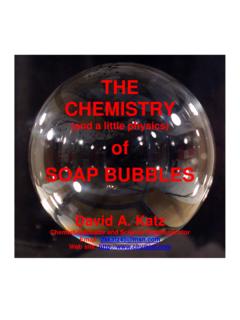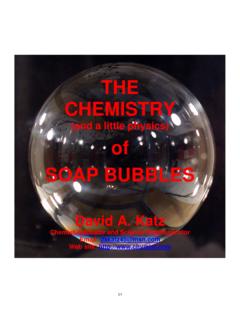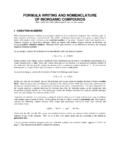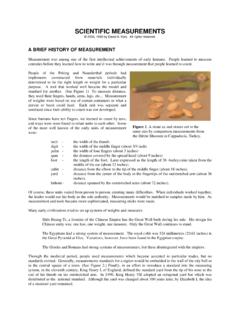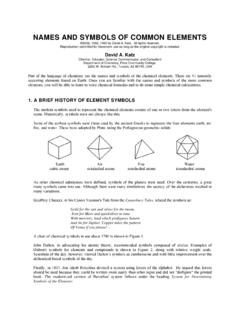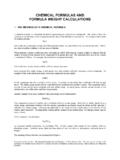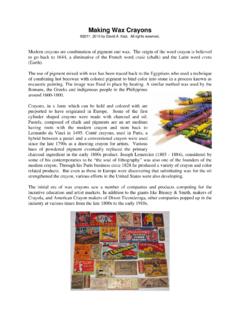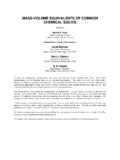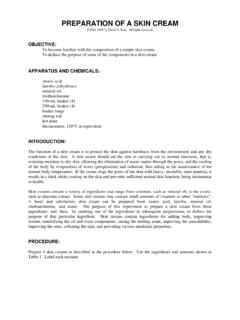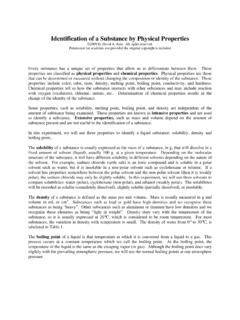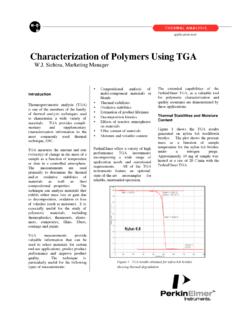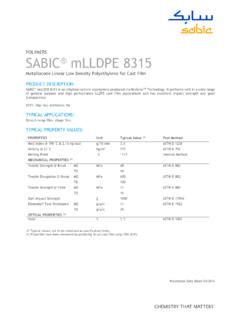Transcription of POLYMERS - chymist.com
1 POLYMERS 1998, 1981, by David A. Katz. All rights reserved. David A. Katz Chemist, Educator, Science Communicator, and Consultant 1621 Briar Hill Road, Gladwyne, PA 19035, USA Voice/Fax: 610-642-5231 Email: Introduction Natural POLYMERS (from the Greek poly meaning many and meros meaning parts ) are found in many forms such as horns of animals, tortoise shell, shellac (from the lac beetle), rosin (from pine trees), asphalt, and tar from distillation of organic materials. One of the most useful of the natural POLYMERS was rubber, obtained from the sap of the hevea tree. (Rubber was named by the chemist Joseph Priestley who found that a piece of solidified latex gum was good for rubbing out pencil marks on paper.)
2 In Great Britain, erasers are still called rubbers .) Natural rubber had only limited use as it became brittle in the cold and melted when warmed. In 1839, Charles Goodyear discovered, through a lucky accident, that by heating the latex with sulfur, the properties were changed making the rubber more flexible and temperature stable. That process became known as vulcanization. The first synthetic polymer , a phenol-formaldehyde polymer , was introduced under the name Bakelite , by Leo Baekeland in 1909. Its original use was to make billiard balls. Rayon, the first synthetic fiber was developed as a replacement for silk in 1911. Although many POLYMERS were made in the following years, the technology to mass produce them was not developed until World War II, when there was a need to develop synthetic rubber for tires and other wartime applications and nylon for parachutes.
3 Since that time, the polymer industry has grown and diversified into one of the fastest growing industries in the world. Today, POLYMERS are commonly used in thousands of products as plastics, elastomers, coatings, and adhesives. They make up about 80% of the organic chemical industry with products produced at approximately 150 kg of POLYMERS per person annually in the United States. RUBBER, A Natural polymer Natural latex is found in the inner bark of many trees, especially those found in Brazil and the Far East. The white sticky sap of plants such as milkweed and dandelions is also a latex. Latex will turn into a rubbery mass within 12 hours after it is exposed to the air.
4 The latex protects the tree or plant by covering the wound with a rubbery material like a bandage. Natural rubber is a polymer of isoprene (2-methyl-1,3-butadiene, see Figure 1) in the form of folded polymeric chains which are joined in a network structure and have a high degree of flexibility (See Figure 2). Upon application of a stress to a rubber material, such as blowing up a balloon or stretching a rubber band, the polymer chain, which is randomly oriented, undergoes bond rotations allowing the chain to be extended or elongated (See Figure 3). The fact that the chains are joined in a network allows for elastomeric recoverability since the cross-linked chains cannot irreversibly slide over one another.
5 The changes in arrangement are not constrained by chain rigidity due to crystallization or high viscosity due to a glassy state. Since latex will solidify in air, a stabilizer is added to prevent polymerization if the latex is to be stored or shipped in liquid form. The stabilizer is usually to 1% ammonia. When the ammonia is removed by evaporation or by neutralization, the latex will solidify into rubber. CH3 CH2=C-CH=CH2 Figure 1. 2-methyl-1,3-butadiene polymer name Monomer(s) polymer Use Polyethylene CH2=CH2 (ethene) CH2 CH2 Most common polymer . Used in bags, wire insulation, and squeeze bottles Polypropylene CH2=CH CH3 (1-propene) CH2 CH CH3 Fibers, indoor-outdoor carpets, bottles Polystyrene CH2=CH (styrene) CH2 CH Styrofoam, molded objects such as tableware (forks, knives and spoons), trays, videocassette cases.
6 Poly(vinyl chloride) (PVC) CH2=CH Cl (vinyl chloride) CH2 CH Cl Clear food wrap, bottles, floor covering, synthetic leather, water and drain pipe Polytetrafluoroethylene (Teflon) CF2=CF2 (tetraflouroethene) CF2 CF2 Nonstick surfaces, plumbing tape, chemical resistant containers and films Poly(methyl methacrylate) (Lucite, Plexiglas) CO2CH3 CH2=C CH3 (methyl methacrylate) CO2CH3 CH2 C CH3 Glass replacement, paints, and household products Polyacrylonitrile (Acrilan, Orlon, Creslan) CH2=CH CN (acrylonitrile) CH2 CH CN Fibers used in knit shirts, sweaters, blankets, and carpets Poly(vinyl acetate) (PVA) CH2=CH OOCCH3 (vinyl acetate) CH2 CH OOCCH3 Adhesives (Elmer s glue), paints, textile coatings, and chewing gum Natural rubber CH3 CH2=C CH=CH2 (2-methyl-1,3-butadiene) CH3 CH2 C=CH CH2 Rubber bands, gloves, tires, conveyor belts, and household materials Polychlorprene (neoprene rubber) Cl CH2=C CH=CH2 (2-methyl-1,3-butadiene)
7 Cl CH2 C=CH CH2 Oil and gasoline resistant rubber Styrene butadiene rubber (SBR) CH2=CH CH2=CH CH=CH2 CH2 CH CH2 CH CH CH2 Non-bounce rubber used in tires Table 1. Addition POLYMERS Figure 2. Schematic sketch of a typical Figure 3. Elastic deformation elastomeric network. of a rubber chain. Make a Rubber Ball from Rubber Latex Safety Precautions Wear safety goggles at all times in the laboratory. When noting the odor of the rubber latex, cup your hand and waft the vapors toward you.
8 Do not take a deep breath of the material. Make sure the rubber ball is submerged under water when squeezing out the excess liquid to prevent it squirting onto anyone. Materials needed Rubber latex Vinegar Stirring rod Paper cup Measuring devices Procedure Measure 20 mL of rubber latex into a paper cup. Carefully, smell the material. Describe its odor. Pour a few drops of latex onto the palm of your hand. Spread it out using your finger. Observe any changes that take place. Add 20 ml of water to the latex in the cup and stir. Add 20 mL of vinegar to the cup and stir the mixture. Remove the mass from the cup and stirring rod with your fingers.
9 Carefully squeeze the mass while washing it underwater. Form the mass into a ball by repeatedly rotating it ands squeezing it. Dry the rubber with a paper towel. Drop the rubber on the floor and describe what happens. polymer name Monomers polymer Use Polyamides (nylon) Fibers, molded objects Polyesters (Dacron, Mylar, Fortrel) Linear polyesters, fibers, recording tape Polyesters (Glyptal resin) Cross-linked polyester, paints Polyesters (Casting resin) Cross-linked with styrene and benzoyl peroxide, fiberglass boat resin, casting resin Phenol-formaldehyde (Bakelite) Mixed with fillers, molded electrical cases, adhesives, laminates, varnishes Cellulose acetate (cellulose is a polymer of glucose)
10 Photographic film Silicones Water-repellent coatings, temperature-resistant fluids and rubber Polyurethanes Foams, rigid and flexible, fibers Table 2. Condensation POLYMERS BAKELITE, The First Synthetic polymer Bakelite, a phenol-formaldehyde polymer , was the first completely synthetic plastic, first made by Leo Baekeland in 1907. Baekeland and an assistant started their research in 1904 looking for a synthetic substitute for shellac. Bakelite was commercially introduced in 1909. Bakelite was first used to make billiard balls, but, later, was used to make molded insulation, valve parts, knobs, buttons, knife handles, many types of molded plastic containers for radios and electronic instruments, and more.
